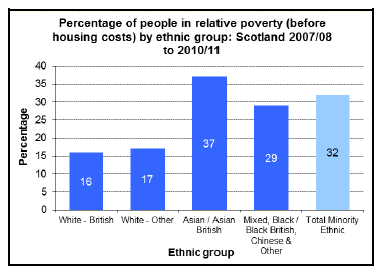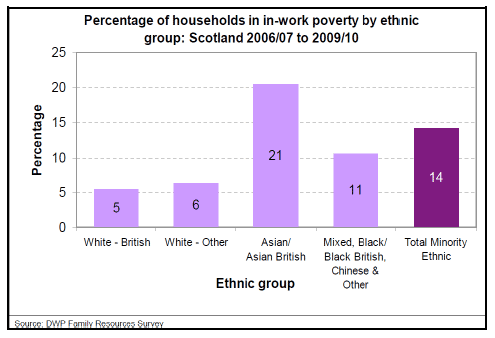Scottish Government Equality Outcomes: Ethnicity Evidence Review
This evidence review was prepared to support the production of the Scottish Government's Equality Outcomes, with regard to ethnicity.
6 Poverty
6.1 This section addresses relative poverty, in-work poverty, financial security, and the anticipated impacts of welfare reform.
Relative poverty
6.2 In its Income and Poverty Analysis58, the Scottish Government reports the percentage of households in relative poverty (before housing costs) by ethnic group - see Figure 8. These figures are based on aggregated data, from 2007/8 to 2010/11 inclusive, because of small samples; as a result, trend data cannot be provided. The mixed, black/ black British, Chinese and other ethnic groups all have sample sizes that are too small to reliably report on their own, so they have been combined into a single category.
Figure 8: Relative poverty by ethnic group (Source: Income and Poverty Analysis, 2012)

6.3 The Income and Poverty Analysis observes that people from ethnic minority groups are around twice as likely to be in relative poverty (before housing costs) than those from the white British group (32% and 16% respectively). 37% of people from the Asian/Asian British group are in poverty, whilst for the combined mixed, black/black British, Chinese and other group, the figure is 29%. Those in the white other group are slightly more likely than those in the white British group to be in poverty (17% poverty rate compared to 16%).
6.4 Analysis of Scottish Household Survey (SHS) data from 2004/0559 shows that, before housing costs, 25% of all individuals living in households headed by an adult from an ethnic minority group were on a low income. This compares with 16% of those living in households headed by a white adult. After taking account of housing costs, 29% of individuals living in a household headed by an adult from an ethnic minority group were living in relative low-income households, compared with 18% of those living in a household headed by a white adult. More recently, the Equality Statement for the Scottish Spending Review 2011 and Draft Budget 2012-1360 reported that ethnic minority households "generally have lower incomes".
6.5 The Scottish Government (2012)61 quotes the findings of the Wealth and Assets Survey 2006/08 at the Great Britain level:
Bangladeshi and Black African groups are positioned very low in the wealth distribution, as are the Pakistani, Black Caribbean and Chinese groups… The Indian and White British groups are ranked close to the middle of the wealth distribution indicating no significant disadvantage relative to the wider population.
In-work poverty
6.6 The Position of Scotland's Equality Groups62 reports the percentage of households in in-work poverty by ethnic group (see Figure 9). These figures are based on aggregated data from 2006/07 to 2009/10 inclusive. The mixed, black/ black British, Chinese and other groups again all have sample sizes that are too small to reliably report on their own, and so they have been combined into a single category so that they can be reported.
Figure 9: In-work poverty and ethnicity.

6.7 Twenty-one percent of households from the Asian/Asian British group were in in-work poverty compared with 5% of households from the white British group. If the data for all of the ethnic minority groups were combined, this figure would reduce to 14%.
Financial security
6.8 The Scottish Government reports data from 2009/10 showing members of ethnic minorities are less likely to be coping financially and more likely to have no savings63. Seventeen percent of those in ethnic minority groups are 'not coping' financially compared, with around 11% for the white groups. Fifty-four percent of ethnic minority households have no savings, and a further 21% have savings less than £1,500.
6.9 The Scottish Government quotes the Family Resources Survey 2007/0864, which found that at the Great Britain level:
Some ethnic minorities are particularly likely to lack access to standard financial products, especially Pakistani and Bangladeshi women who are three times as likely as white men and women not to have a bank account. The majority of Pakistani and Bangladeshi households do not have contents insurance. Some religious and ethnic groups may be excluded from credit by a lack of the availability of loans on terms that conform to their beliefs.
Welfare reform
6.10 The Department for Work and Pensions (DWP) has published an Equalities Impact Assessment for the Universal Credit65. It models the positive impact of Universal Credit on the distribution of the participation tax rate (calculated as the proportion of earnings which are lost in tax, national insurance or reduced benefit payments when a person moves into work), for people moving into ten hours of work per week at the minimum wage. Individuals from both a white and an ethnic minority background are expected to see almost equal improvements in their incentive to move into work at this level: under Universal Credit, 94% of white individuals and 96% of ethnic minority individuals will have participation tax rates below 60%, compared with 35% and 36% respectively under the current system.
6.11 The DWP estimates that Universal Credit will reduce poverty for 350,000 individuals (200,000 adults and 150,000 children) in households with at least one ethnic minority adult, which is a larger proportional reduction in poverty than that experienced by households with only white adults. Households with a member from an ethnic minority background are more likely to gain than other households, because they are proportionally more likely to be both in couples and in lower paid employment, than households without a member from an ethnic minority background.
6.12 The DWP's impact assessment of the new Benefits Cap66 expects that a high proportion of those affected by the cap are likely to be large families, implying that households from cultural backgrounds with a high prevalence of large families are more likely to be affected. The DWP estimates that, of the households likely to be affected by the cap, approximately 40% will contain somebody who is from an ethnic minority. By comparison, the DWP's statistics show that 17% of Jobseeker's Allowance claimants, 16% of the lone parents claiming Income Support and 9% of Employment and Support Allowance are from the ethnic minorities.
Contact
Email: Social Research
There is a problem
Thanks for your feedback